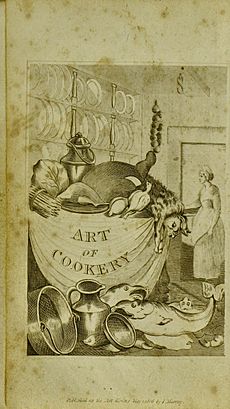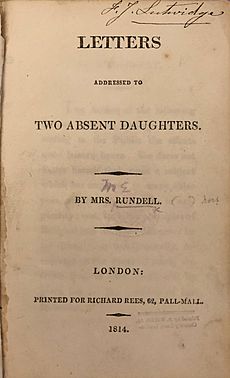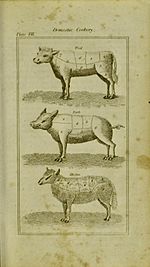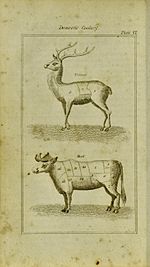Maria Rundell facts for kids
Quick facts for kids
Maria Rundell
|
|
|---|---|

Title page of A New System of Domestic Cookery, 1806 edition
|
|
| Born | 1745 Ludlow, Shropshire, England
|
| Died | 16 December 1828 (aged 82–83) Lausanne, Switzerland
|
| Nationality | English |
|
Notable work
|
A New System of Domestic Cookery |
| Spouse(s) | Thomas Rundell |
Maria Eliza Rundell (1745 – 16 December 1828) was an English writer. Not much is known about most of her life. But in 1805, when she was over 60, she sent a collection of recipes and home advice to John Murray. His family owned the John Murray publishing house, and she was a friend of theirs. She didn't expect any money for her work.
Murray published her book, A New System of Domestic Cookery, in November 1805. It was a huge hit! Many editions were printed, and the book sold about half a million copies during Rundell's lifetime. The book was written for middle class housewives. It taught them how to cook and also gave tips on home remedies. It even showed how to set up a home brewery and had a section called "Directions to Servants". The book included an early recipe for tomato sauce and the first printed recipe for Scotch eggs. Rundell also advised readers to be smart with their food and avoid waste.
In 1819, Rundell asked Murray to stop publishing her cookbook. She was unhappy because she felt the book's quality had gotten worse with each new edition. She wanted to publish a new version with a different company. This led to a court case that lasted until 1823. Finally, Rundell accepted Murray's offer of £2,100 for the rights to her book.
Rundell wrote a second book, Letters Addressed to Two Absent Daughters, which came out in 1814. This book was like a mother giving advice to her daughters. It covered topics such as dealing with death, friendship, how to act in polite company, and what books a young woman should read. Maria Rundell died in December 1828 while visiting Lausanne, Switzerland.
About Maria Rundell's Life
Maria Eliza Ketelby was born in 1745. Her parents were Margaret (née Farquharson) and Abel Johnson Ketelby. Maria was their only child. Her father, Abel Ketelby, was a lawyer who lived with his family in Ludlow, Shropshire.
It's surprising how little we know about Maria Rundell's personal life. Writers Mary Aylett and Olive Ordish noted that even though many people's lives were recorded back then, the life of this very popular writer is mostly a mystery.
On December 30, 1766, Maria married Thomas Rundell. He might have been a surgeon from Bath, Somerset, or a jeweller from the famous company Rundell and Bridge in London. Maria and Thomas had two sons and three daughters.
The family lived in Bath at some point, and they might have also lived in London for a while. Thomas died in Bath in 1795 after being sick for a long time. After his death, Maria Rundell moved to Swansea, South Wales. She might have gone to live with one of her married daughters there. She sent two of her other daughters to London to live with their aunt and uncle.
How Maria Rundell Became a Writer

While she was married and after her husband passed away, Maria Rundell collected recipes and tips for running a home. She gathered these for her daughters. In 1805, when she was 61, she sent her collection to John Murray. His family owned the John Murray publishing house, and Maria was a friend of theirs.
It had been many years since other popular cookbooks were published in Britain. John Murray realized there was a need for a new one. Maria's collection was almost ready to be published. Murray added a title page, a front picture, and an index. He also had the collection edited. The first edition of A New System of Domestic Cookery came out in December 1805.
Like many female authors at that time, Maria's book was published under a fake name: "A Lady." Maria didn't want any payment for the book. In some social groups, getting money for writing was seen as improper. The first edition even had a note from the publishers that said: "The advice in this book was meant for the author's own daughters. It was to help them manage their homes and meals well, combining good looks with smart saving... This small book would have been a treasure to her when she first started her own home. So, she hopes it will help others. With that idea, it is given to the public. Since she will not make any money from it, she hopes it will not be criticized."
The book was very popular and successful. Reviewers praised it as a clever and helpful guide for running a home. In 1808, Murray sent Maria £150. He said her gift was more profitable than he expected. She wrote back, saying she never thought she would get anything for what she saw as a free gift to a friend.
In 1814, Maria Rundell published her second book, Letters Addressed to Two Absent Daughters. This book contained advice a mother would give to her daughters. Reviewers thought the book was "always moral" and had "sensible and useful reflections."
By 1819, the copyright for Domestic Cookery had ended. Maria wrote to Murray, asking him to stop selling the book. She told him she would publish a new edition with a different company. She even got a court order to stop him. Murray then sued Maria to prevent her from publishing the book herself. The judge decided that neither side had full rights, and the issue would need to be settled in a proper court. In 1823, Maria accepted Murray's offer of £2,100 for her rights to the book.
Maria Rundell spent much of her later life traveling. She stayed with family and friends, and also went abroad. Her son, Edmund Waller Rundell, joined the famous jewellers Rundell and Bridge. This company was run by Philip Rundell, a relative of Maria's late husband. Edmund later became a partner in the firm. In 1827, Philip died. He left Maria £20,000, and £10,000 each to Edmund and his wife. In 1828, Maria traveled to Switzerland and died in Lausanne on December 16.
Maria Rundell's Books
About Domestic Cookery
The first edition of A New System of Domestic Cookery was 290 pages long and had a full index. It was written in a "plain-speaking" and "charming" way. The book was meant for "respectable middle class" families. It was especially helpful for housewives who might not have learned how to run a home.
Domestic Cookery gave advice on how to make beer at home, recipes for sick people, and a section called "Directions to Servants." It was one of the first complete guides for managing a household. Rundell told readers to be smart with their food and avoid waste. Her introduction began: "The mistress of a family should always remember that the well-being and good management of the house depend on the eye of the person in charge. Nothing is too small for her to notice if it can prevent waste. This attention is even more important now that the price of everything needed for life has increased so much."
The book had recipes for fish, meat, pies, soups, pickles, vegetables, pastries, puddings, fruits, cakes, eggs, cheese, and dairy. Rundell gave detailed instructions to help people get the best results. Some of her recipes came from an earlier cookbook by Mary Kettilby, published in 1714.
The food writer Alan Davidson noted that Domestic Cookery didn't have many brand new ideas. However, it did have an early recipe for tomato sauce. The fourth edition, printed in 1809, had the first printed recipe for Scotch eggs.
Later editions of the book were made bigger, and small mistakes were fixed. New parts included medical remedies and advice. One writer noted that these tips could help women avoid the embarrassment of seeing a male doctor. The 1840 edition was expanded by author Emma Roberts. She added many Anglo-Indian recipes. This new edition, the sixty-fourth, included seven recipes for curry powder, three for Mulligatawny soup, and seventeen different curries. For this edition, a note was added under Rundell's original statement about not taking money. It said: "The author, Mrs Rundell, sister of the famous jeweller on Ludgate Hill, was later convinced to accept the sum of two thousand guineas from the publisher."
About Letters Addressed to Two Absent Daughters
Letters Addressed to Two Absent Daughters is made up of thirty-eight letters. They are written from a mother to her two daughters, Marianne and Ellen, who are away from home. The advice included how to act politely in public, what kinds of books a well-behaved young woman should read, and how to write letters. At that time, it was common for girls and young women not to have formal schooling. So, mothers often gave this kind of advice. The book doesn't include any replies from the daughters, but the mother's letters sometimes mention getting "your joint letters."
Maria Rundell's Lasting Impact
A New System of Domestic Cookery was the most important cookbook in the early 1800s. It sold more copies than any other similar book. There were sixty-seven editions published between 1806 and 1846. It sold over half a million copies during Maria Rundell's lifetime. New editions continued to be released until the 1880s. In America, there were fifteen editions between 1807 and 1844, and thirty-seven in total.
Maria Rundell's work was copied by at least five other publishers. In 1857, when Isabella Beeton started writing the cooking column for The Englishwoman's Domestic Magazine, many of her recipes were taken from Domestic Cookery. In 1861, Isabella's husband, Samuel, published Mrs Beeton's Book of Household Management. This book also contained several of Rundell's recipes. Domestic Cookery was also copied a lot in America. Rundell's recipes appeared in Mary Randolph's 1824 book The Virginia House-Wife and Elizabeth Ellicott Lea's A Quaker Woman's Cookbook.
Maria Rundell is mentioned about twenty times in the Oxford English Dictionary. This includes for terms like "apple marmalade," "Eve's pudding," "marble veal," and "neat's tongue."
Many modern cooks and food writers have admired Maria Rundell. The 20th-century cookery writer Elizabeth David often mentioned Rundell in her articles. She included Rundell's recipe for "burnt cream" (crème brûlée). In her 1970 book Spices, Salt and Aromatics in the English Kitchen, David included Rundell's recipe for fresh tomato sauce. She wrote that this "appears to be one of the earliest published English recipes for tomato sauce." In English Bread and Yeast Cookery (1977), she included Rundell's recipes for muffins, Lancashire pikelets (crumpets), "potato rolls", Sally Lunns, and black bun.
The food writer and chef Michael Smith used some of Rundell's recipes in his 1973 book Fine English Cookery. He updated old recipes for modern cooking. The food writer Jane Grigson also admired Rundell's work. In her 1978 book Jane Grigson's Vegetable Book, she referred to Rundell's writing and included her recipe for red cabbage stewed in the English style.
See also
 In Spanish: Maria Rundell para niños
In Spanish: Maria Rundell para niños





